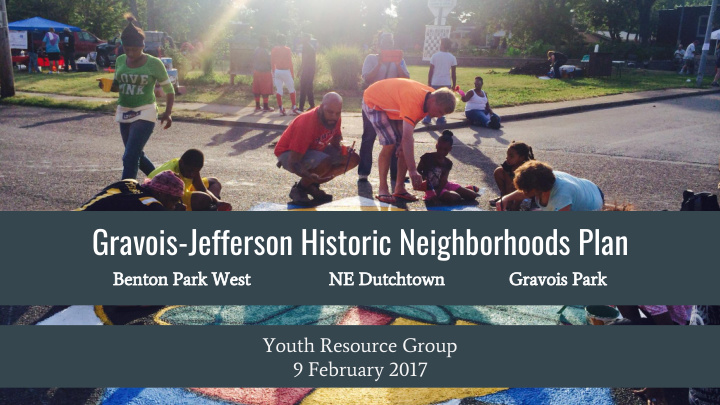



Gravois-Jefferson Historic Neighborhoods Plan Benton Park West NE Dutchtown Gravois Park Youth Resource Group 9 February 2017
Gravois-Jefferson Historic Neighborhoods Plan Community Plan: a public document which ● contains specific proposals for future development and public improvements in a given community. Based off engagement with local residents and ● community leaders, it provides policies and a long-range physical development guide for elected officials and citizens engaged in community development. Project Partners: ● Resident Steering Committee ○ Rise Community Development ○ Dutchtown South Community Corporation ○ Local aldermen and other stakeholders ○
Benton Park West Gravois Park Dutchtown (northeast area) The area is home to approximately 13,000 ● residents, diverse in age, race and socioeconomic status. The planning process will go through Summer ● 2017, and feature multiple public meetings, group focus sessions, one-on-one conversations, and other forms of engagement. The Plan MUST be representative of the rich ● diversity of these neighborhoods. This requires intentional outreach to: People of Color ○ Lower-income Individuals and Families ○ Young People ○
There are many schools, nonprofits and youth-based Youth and Families: organizations in the immediate and nearby area: Data and Information ● ● Cherokee Recreation 28 to Life Center ● Youth in Need ● Marquette Recreation ● South Broadway Art Project Center Of population is UNDER 18 ● Intersect Art Center ● YeYo Arts Collective 30% ● Thomas Dunn Learning Center (Benton Park West: 31% youth population; ● Neighborhood Houses ● Froebel Elementary Gravois Park: 33% youth population; and (after-school programs) ● Carnahan High School Dutchtown: 28% youth population) ● Hands Up United ● Meramec Elementary ● Cowry Collective Youth ● Cherokee Street Reach Court Time Bank ● Deaconess Foundation ● Neighborhood Of households with children are 49% ● C.A.M.P. Accountability Board- living in poverty ● Dutchtown, Gravois Park, Salvation Army Benton Park West ● United Way ● Benton Park West ● Kingdom House Neighborhood Association ● Anti-racist Coalition Of households are single women Youth Chair 14% ● Roosevelt High School ● St. Lukes Lutheran Church with children ● International Institute ● Gene Slay's Boys and Girls ● Alive and Well STL Club ● Boys and Girls Club ● St. Mary's High School ● Mathews-Dickey ● Ready by 21
Gravois-Jefferson Historic Neighborhoods Plan PROGRESS UPDATE
Gravois-Jefferson Plan: Public Kick-Off Meeting: November 1, 2016 Previous Meetings Steering Committee Meeting #1: September 29, 2016 Steering Committee Meeting #2: November 10, 2016 Steering Committee Meeting #3: December 19, 2016 Steering Committee Meeting #4: February 1, 2017 Public Working Meeting #1: November 29, 2016 Additional Engagement with residents, business owners, local organizations, churches, non-profits, schools, and more.
Gravois-Jefferson Plan: Community Feedback Input from over 250 people in the form of 1,000+ pieces of data have provided the following insights: Key Areas of Focus for the Planning Effort should be: ● Safety and Security Youth and Families Economic Development and Prosperity ○ Mapping and Cataloguing of Community Characteristics show: ● Strengths Opportunities Challenges Diversity in Race, Age, Empower youth to own Vacant and Abandoned ➔ ➔ ➔ Ethnicity, Lifestyle community growth Properties Density Minority-owned Business Crime and Safety ➔ ➔ ➔ Beautiful Architecture Expansion Concerns ➔ Cherokee Street and Educate and Build Employment Opportunity ➔ ➔ ➔ Commercial Areas Awareness of Resources ● We need to ensure our process is representative of the racial, socioeconomic, and age diversity of these neighborhoods. The process should engage residents and not prioritize outside stakeholders
Recommend
More recommend